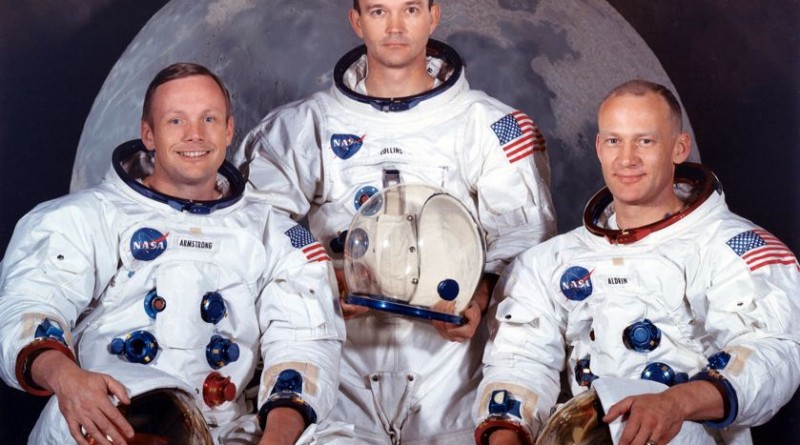Events Leading up to the First Moon Landing 46 Years Ago
“That’s one small step for man, one giant leap for mankind”, These words uttered by Neil Armstrong are now 46 years old.
The following data-burst captures the excitement of the greatest adventure of all time.
- In 1865 French author Jules Verne published From the Earth to the Moon, a fiction story of a spacecraft sent to the moon from a launching site in Florida.
 After almost hundred years, Florida was indeed the starting point of human’s first expedition to the Moon.Astonishingly the spacecraft aboard astronauts returning to Earth was splashed down in the Atlantic Ocean at the same location mentioned by Jules Verne in his story.
After almost hundred years, Florida was indeed the starting point of human’s first expedition to the Moon.Astonishingly the spacecraft aboard astronauts returning to Earth was splashed down in the Atlantic Ocean at the same location mentioned by Jules Verne in his story. - The outbreak of Russians firsts in space was infuriating for Americans in the 1960’s and headed to a strategy more glorious than any for a win to USA.President John Kennedy affirmed that the USA would land a man on the Moon by 1970, and saw to it that his aim received bounteous government support.Although he did not live to see the dream realized, but the prediction came true with time to spare, on July 21 1969, Apollo-11 launched from Cape Canaveral, Florida landed on the Moon.
- The command pilot of the Apollo-11 mission, Neil Armstrong of Scottish and German ancestry, became the first man to set foot on the Moon, at 02.56 and 15 seconds GMT on 21 July, 1969.
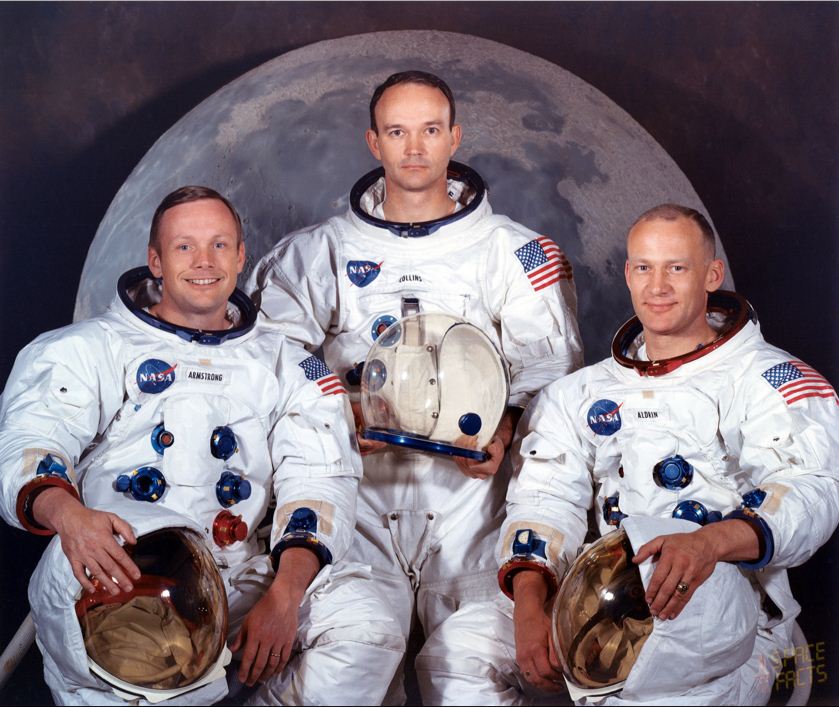
(starting from left: Armstrong, Collins , Aldrin) He was followed out of the lunar module Eagle by Col. Edwin Aldrin of Swedish, Dutch and British ancestry, while the command module Columbia was piloted by Lt.Col. Michael Collins of Irish and pre-revolutionary American ancestry, orbited above.
- Born on 5th August 1930, Neil Armstrong got his pilot’s license at 16, before he got his driver’s license. In Korean War, he flew Panther Jets from carrier Essex, ran up to a total of 78 combat missions.After the war, he joined the space agency NASA and flew the rocket-powered X-15 aircraft up to heights of 60,975 meters (2, 00,000 feet’s) at speeds of 6,400 kilometers/hour.Being Apollo-11’s commander, he was also a civilian, the highest paid man in the astronaut ranks drawing a salary of some 30,000 dollars a year.
- The astronauts were subject to rigorous training exercises before the flight, in which they were subjected to high g-force, which was expected to be acting on them while the lift.They took it up to 21 g for 5 seconds, which is very high.What does it feel like?By around 6g you start to lose peripheral vision, then you begin to feel pain in chest, also as the force displaces the heart within the body resulting in alterations in circulatory systems, and it becomes painful to use to use your hands, legs or even to move your head. It has been described as an elephant sitting on your chest.
- The question of who would be the first man down the ladder when the Apollo-11 lunar module lands on the Moon was unanswered until shortly before the launch on July 16, 1969.As mission commander Neil Armstrong seemed to merit the honour. But lunar module pilot Edwin Aldrin was convinced that he would be the first man on the Moon, as he saw it, sea captains and space commanders were customarily last to leave their ships.Ultimately, Armstrong exercised his commander’s privilege.
- Saturn-V, was the most powerful rocket at the time used for Apollo-11 lunar exploration mission. The development started in January, 1962 at John F. Kennedy Space Centre, Florida.The 29,12,925 kilogram rocket was 110,9 meters (363 feet and 8 inches) tall, carried a payload of 20,385 kilogram and gulped 13.6 tonnes of propellant per second for 2.5 minutes.
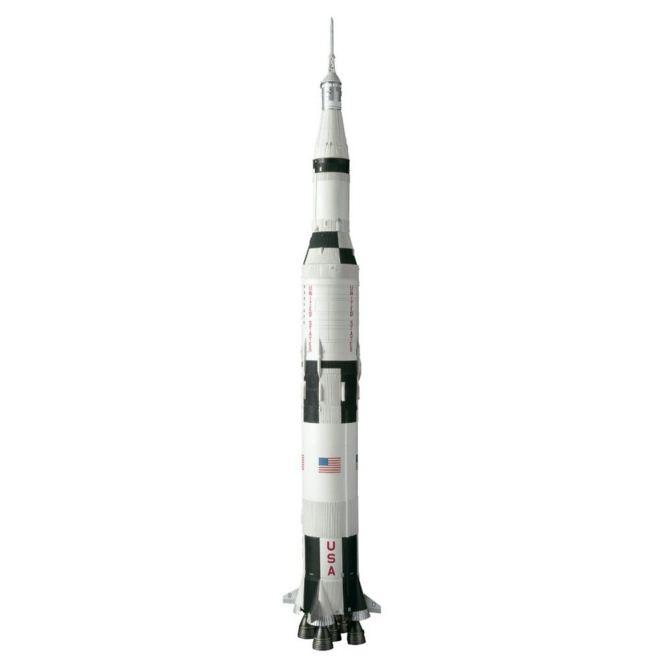
(Saturn-V) Stage-1 was of 42.2 meters (138 feet 6 inches) tall and was powered by five F-1 engine, using liquid oxygen/LOX and kerosene, each delivering 15, 00,000 pounds of thrust.
Stage-2 was powered by five LOX and liquid hydrogen J-2 engines with total thrust of 11, 50,000 pounds.
The whole assembly generated 17, 56,00,000 horsepower and weighed 29, 24,700 kilograms fully loaded.
- The mighty Saturn-V was indeed monstrous in every detail, with a total of 92 engines, 24 kilometres of wiring and laden with 19, 84,500 litres of liquid hydrogen and liquid oxygen fuel,that if blew up, its flames would reach 914 meters diameter.
 It was some 18.3 meters (60 feet) taller than the statue of liberty and 13 times heavy when fully loaded.
It was some 18.3 meters (60 feet) taller than the statue of liberty and 13 times heavy when fully loaded. - When lifting off, the 36-storey tall Saturn-V rocket produced power output that could be just enough to light up New York City for 75 minutes, breaching out in flames which were 244 meters long.
- The Vehicle Assembly Building at Complex 39 was the most capacious building ever constructed at the selected final assembly site of the Saturn-V rocket at Cape Kennedy (from Cape Canaveral), Florida.
 With estimated floor area of 31,945 square meters (7.87 acres) and a capacity of 36,25,496 cubic meters , was completely constructed on 14th April 1965 at the cost of 10,87,00,000 dollars.In this giant building the Saturn-V was assembled.
With estimated floor area of 31,945 square meters (7.87 acres) and a capacity of 36,25,496 cubic meters , was completely constructed on 14th April 1965 at the cost of 10,87,00,000 dollars.In this giant building the Saturn-V was assembled. - Another monstrous machine used in the mission was caterpillar vehicle; it was used to transport Saturn-V to the launching site after being completely assembled in the Vehicle Assembly Building.Two of these were built at the same time at the cost of 1,23,00,000 dollars and 40X34.75 meters in dimension.

Original Caterpillar monster machine in action. The load train weight was 8,165 tonnes, its 106.6 centimetres (42 inch) wind shield wipers were world’s longest.
- The day after the countdown began President Richard Nixon announced that he was regretfully cancelling plans to dine with the astronauts before the flight.Actually, doctors had ruled against the meeting, for the astronauts might pick up stray germs that could develop infection during the mission.Nevertheless, President Nixon made a five minutes telephone call to Armstrong, Aldrin and Collins from his White house office , ‘you carry with you a feeling of good will in this greatest adventure man has ever undertaken’, he said.
- Each Apollo’s Astronaut was allowed to carry with him a Pilot’s Preference kit to the moon, which included 225 grams of personal items, as long as they were not flammable, alcoholic or drug related.Aldrin took along a tiny gold chalice, a table spoonful of red wine and a wafer which he consumed after a private prayer a few moments after landing on the moon.
- The Apollo-11 space craft was divided in 3 modules, the conical command module was the main cabin for the three astronauts aboard Apollo. Behind it was the cylindrical service module which consisted the main engine, fuel and oxygen supply. In front of the command module was lunar module, a strong spider shaped craft with legs for leading on the Moon.
- Soon after leaving the Earth orbit, the astronauts would pilot the combined command and service modules around the dock with the Lunar Module which was in separate compartment of the rocket.Once in the grasp of the lunar gravity after entering lunar orbit the LM would detach from the command module, with Armstrong and Aldrin onboard, it would slowly descend to the moon surface with module pilot Collins remained behind orbiting the Moon.
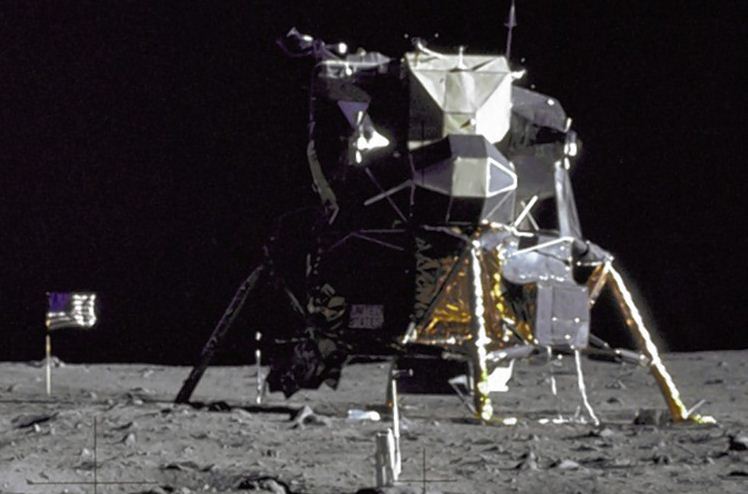
Lunar Module on Moon surface. After the work on moon was completed the LM would lift off leaving its legs behind and redock to the command module, the command module than use its thrusters to direct its course towards the earth.
- During Apollo-11 mission the moon moved more than 2,64,000 kilometres, therefore the space craft was aimed at the spot 2,64,000 kilometres ahead of the moon, so as to reach this spot exactly the same time as that the moon would.
- At 9:32, local time, on July 15, 1969, Apollo-11 lifted off launch pad 39A at Cape Kennedy.Great flames of burning fuel billowed out of the rocket while 1,89,000 liters of water per minute was sprayed throughout the holocaust to absorb the heat.The astronauts were on the way, History was about to be made.
- When the astronauts Armstrong and Aldrin came closer to the Moon, they came close to a disaster. As their module, Eagle, dropped from its orbit round the moon, it was essential to find a smooth place on which to land.There was fuel in the descent tank for only 60 seconds; Armstrong must find a landing site-or Aldrin would be forced to switch to the ascent tank and abort the mission. Still Eagle descended to 9 meters, if it ran out of fuel at this altitude, it would crash on moon’s surface before the ascent engine could lift it off back in to the orbit.Just as the descent engine sucked up the last of its fuel supply Armstrong put the module down on the Moon.
- Just after the landing both the Astronauts checked their equipment’s; Armstrong opened the hatch, squeezed through with his backpack, containing his portable life support system, and began climbing down the nine-step ladder.
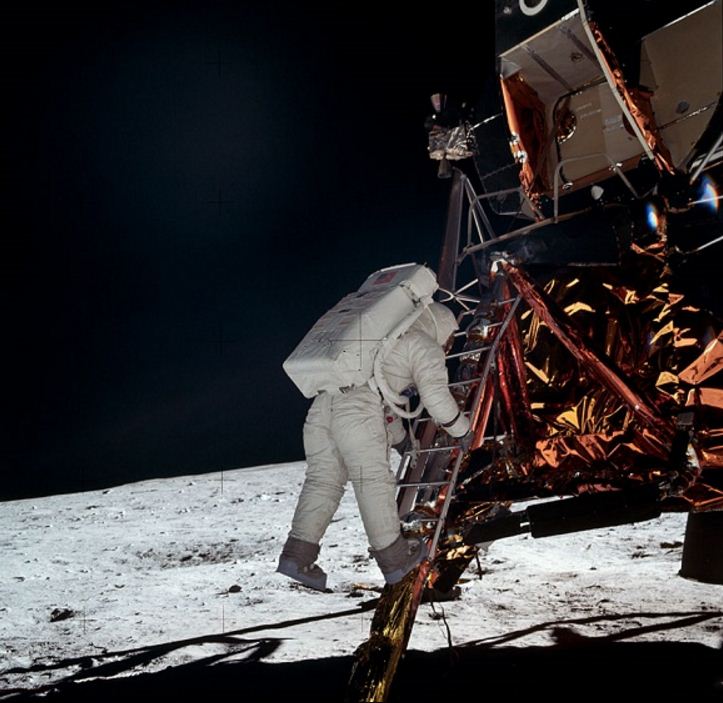 Armstrong’s left foot touched the ground at 10:56 P.M. he than his off quoted landing statement ‘that’s one small step for man, one giant leap for mankind’.
Armstrong’s left foot touched the ground at 10:56 P.M. he than his off quoted landing statement ‘that’s one small step for man, one giant leap for mankind’. - From one of the legs of the LM, the Astronauts extracted a 3×5 feet nylon United States flag, it was hung on a pole driven in to the soil, but braced by spring wire at the top to keep it extended on airless Moon. When the flag was erected both men stepped back and saluted it.President Nixon than called them on the Apollo Communications network and congratulated them in what he described ‘has to be the most historic telephone call ever made.’
- Armstrong than scooped out 2 batches of soil samples weighing 1.4 kilograms with the help of a scoop on end of a pole so that he would not have to bend to collect, and stored these samples in the bag in the left leg pocket of the spacesuit.Armstrong than set up a laser mirror designed to reflect a laser beam from Earth telescope back to its source, it consisted of 100 high precision reflectors set in a aluminium frame 46 centimeters square.
 By reflecting ruby laser beam fired at it the mirror would enable the scientist to calculate distance between moon and earth more precisely than ever.
By reflecting ruby laser beam fired at it the mirror would enable the scientist to calculate distance between moon and earth more precisely than ever. - At 12:54 A.M. on July 21, 1969, after 1 hour and 43 minutes on the Moon’s surface Aldrin climbed up the ladder and re-entered the LM Armstrong followed at 1:09 A.M. He had spent 2 hours and 13 minutes on the Moon; nearly 12 hours later at 1:54 P.M., the Moonwalkers ignited the LM ascent engine.This lifted them off in to the lower lunar orbit from which they expertly made rendezvous with their colleague, Michael Collins, the ‘unsung Hero’ of that expedition, who had been orbiting the Moon in command module while his partners were making history on the Moon.
- The end of a space flight is the most dangerous part for the astronauts aboard, they were supposed to enter Earth’s orbit at a certain angle to make a safe entry in to the atmosphere and hence precede the landing.If the angle had been too shallow the spaceship would have been bounced back in to the space lost in the endless deep space bouncing around, if the angle was too deep the space craft might have burned up.
- After Apollo-11 returned to the Earth the lunar material, the astronauts and the equipment’s that were exposed to lunar atmosphere were kept in quarantine.
 The purpose of this isolation period, which lasted about 17 days for the astronauts, was to determine whether any germs or other harmful material had been brought back from the Moon, nothing was found.
The purpose of this isolation period, which lasted about 17 days for the astronauts, was to determine whether any germs or other harmful material had been brought back from the Moon, nothing was found. - By the time Apollo programme ended in 1972 with last mission accomplished by Apollo-17’s astronauts, 24 Americans had travelled to the Moon (3 of them twice), 12 Americans had walked on the Moon, and the total lunar stay time was calculated as 12 days, 11 hours and 40 minutes.Weight of moon rocks brought back to Earth in these entire missions was total of 386 kilograms.The only unsuccessful mission was that of Apollo-13. A big explosion on-board the spacecraft left the 3 astronauts with little air or power.
With Apollo-11’s historic journey, USA won the Moon race hands down, closed down the programme and turned towards developing a space station and achieving a long-duration human presence in orbit.

